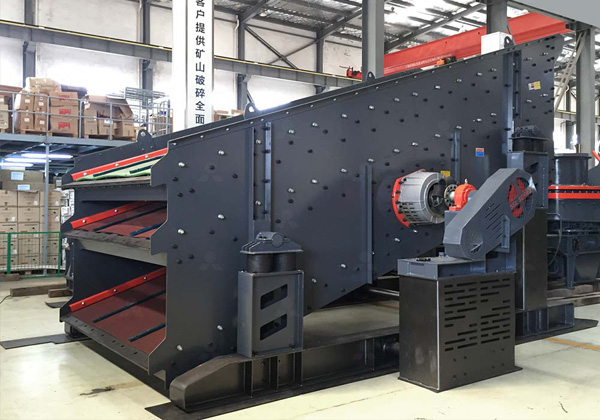The three-layer vibrating screen is an essential piece of machinery used for separating materials in various industries, including mining, construction, and aggregate processing. It is a high-efficiency screening device designed to classify particles based on size, ensuring that materials are sorted effectively and efficiently. In this article, we’ll explore the working principle, components, and applications of the three-layer vibrating screen and discuss optimization techniques to enhance its performance.

Introduction to Three-Layer Vibrating Screens
A three-layer vibrating screen features three levels or layers of screening surfaces that work simultaneously to separate materials into different particle sizes. It is typically used for the separation of bulk materials into fine, medium, and coarse grades, improving the quality of the product and ensuring that particles are efficiently sorted.
Working Principle of a Three-Layer Vibrating Screen
The working principle behind a three-layer vibrating screen relies on the vibration of the screen body and the movement of materials across the surface of the mesh. Here’s how it works:
-
Vibration Mechanism: The vibrating screen is powered by a vibrating motor, which generates a high-frequency, low-amplitude vibration. The motor causes the screen to move in a circular or linear motion, depending on the design, causing the material on the screen to move accordingly.
-
Material Movement: As the vibrating screen moves, materials are thrown against the screen’s surface. Coarse particles, which are too large to pass through the mesh, move to the discharge end of the screen. Smaller particles pass through the mesh and are separated into different sizes depending on the opening of the screen layer.
-
Three Layers: Each layer of the screen has a different mesh size to classify materials into multiple categories:
-
Top layer: This layer is usually designed to screen out the largest particles.
-
Middle layer: This layer filters the intermediate-sized particles.
-
Bottom layer: The smallest particles pass through this layer, ensuring finer material is collected.
As the material moves across the three layers, it is sorted into the desired particle sizes.
-
Key Components of the Three-Layer Vibrating Screen
Several components contribute to the efficient functioning of the three-layer vibrating screen:
-
Vibrating Motor: The motor provides the necessary vibration to move the materials on the screen surface. The motor’s rotation is typically powered by an external power supply, often through an eccentric shaft or unbalanced pulley mechanism.
-
Screen Decks: The screen decks are the surfaces where materials are separated. In a three-layer vibrating screen, there are three separate decks, each with a different mesh size for particle classification.
-
Screen Frame: The frame provides structural support for the entire system, ensuring that the screen can withstand the vibrations without breaking apart.
-
Springs: Springs are used to absorb the vibrations and support the screen’s operation. They help reduce the impact of vibrations on the machine’s frame and other components, extending its lifespan.
-
Feeding Inlet: The material enters the vibrating screen from the feeding inlet, and the distribution of material across the screen is crucial for optimal operation.
Performance of a Three-Layer Vibrating Screen
To ensure that a three-layer vibrating screen performs efficiently and delivers high-quality results, consider the following optimization techniques:
A. Correct Screen Mesh Selection
Choosing the correct mesh size for each layer of the screen is vital. The mesh size should be based on the size of the particles in the material being processed. A finer mesh will allow smaller particles to pass through, while a coarser mesh will filter out larger particles.
B. Adjusting Vibration Frequency and Amplitude
The vibration frequency and amplitude should be adjusted to ensure that the material moves efficiently across the screen. Too high a frequency can lead to over-vibration, while too low a frequency can lead to poor separation efficiency.
-
Optimal Vibration Frequency: It is important to adjust the frequency to match the material type and the desired output. Generally, lower frequencies are used for heavier materials, while higher frequencies are ideal for finer materials.
-
Amplitude Control: The amplitude of the vibration determines how far the screen deck moves. A higher amplitude allows for better material movement, but it can also lead to premature wear and tear. Balancing the amplitude is essential for consistent performance.
C. Proper Feeding of Materials
Ensure that materials are evenly fed onto the screen surface to avoid overloading any one layer. Uneven feeding can lead to inaccurate sizing and poor separation efficiency. A feeder system can help distribute the material evenly across the screen.
D. Regular Maintenance
Routine maintenance, such as cleaning and lubricating moving parts, is necessary to ensure optimal performance. This helps prevent wear and tear, and helps avoid downtime caused by component failure. Also, check for any loose or damaged parts that could affect the operation of the screen.
E. Adjusting Angle and Inclination of the Screen
The angle and inclination of the screen can also influence the separation efficiency. Typically, an inclination of 15–20° is ideal for most vibrating screens, although this may vary depending on material characteristics.
F. Replacing Worn-Out Mesh
As the screen operates, the mesh wears out due to constant friction and vibration. Replacing worn-out mesh is essential to maintain the separation efficiency and ensure a consistent output.
Understanding the working principle and optimizing the screen’s performance can lead to significant improvements in both efficiency and cost-effectiveness, ensuring the longevity of the equipment and the quality of the materials produced.

